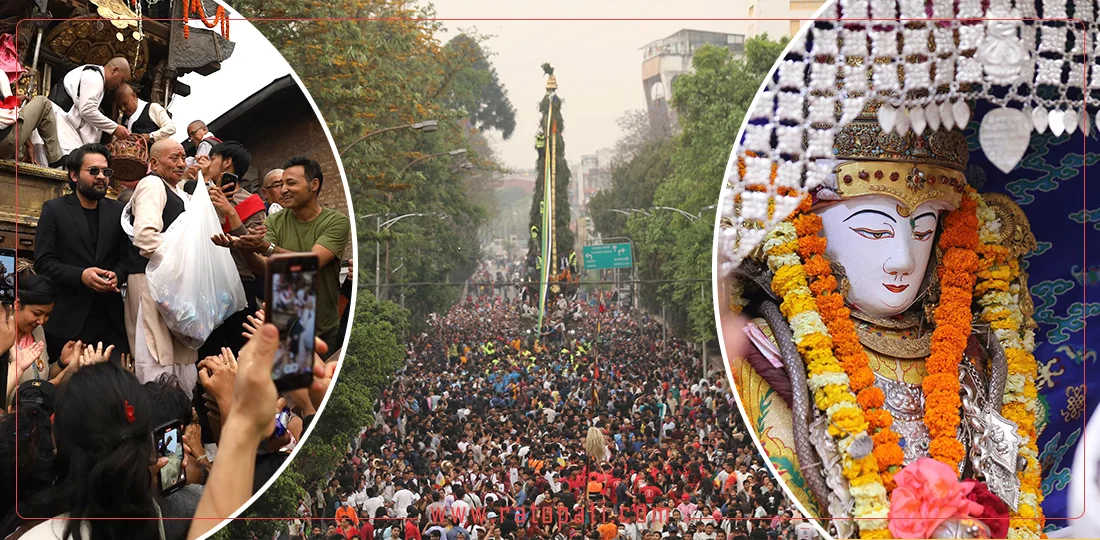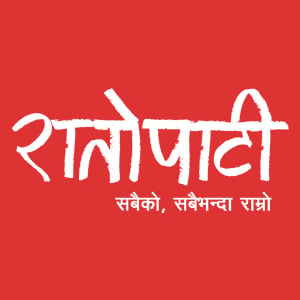KATHMANDU: Amidst great enthusiasm and reverence, the iconic Seto Machhindranath Jatra, one of the grandest chariot festivals in the Kathmandu valley, commenced on Tuesday.
Also known as the ‘Jana Baha Dyah Jatra,’ this three-day-long procession pays homage to the God of Rain, Seto Machindranath. The centerpiece of the festival is the towering chariot bearing the deity, which is meticulously pulled from one location to another over the course of three days.
Devotees from far and wide gathered at Tindhara Pathsala in Durbarmarg, where the elaborate chariot construction had been underway since last week.
According to legend, during the reign of Yakshya Malla, the King of Kantipur, a divine event unfolded. People would cleanse themselves in a sacred river and visit the revered Swayambhunath, believed to possess the power to usher souls into heaven after death. However, when Yama, the God of Death, learned of this power and visited the temple, he was detained by King Malla and his guru, who sought immortality.
Trapped, Yama beseeched Arya Awalokiteshwor (Seto Machhindranath) for liberation. Responding to the plea, the deity manifested, advising the king to construct a temple at the confluence of Kalmati and Bagmati rivers and organize a grand procession to bestow blessings of contentment and longevity upon the people. And thus, the tradition of the Seto Machhindranath Jatra was born.
The festival unfolds over three days, commencing with the ceremonial removal of the Jana Baha Dyah icon from its temple at Jana Baha. It is then transported in a portable shrine to Durbar Marg, where the procession officially begins. The chariot traverses through Jamal and Asan, halting overnight. The following day, it proceeds through Indra Chowk to Kathmandu Durbar Square. On the final day, the procession winds through Maru, Chikan Mugal to Mugal, where it encircles the Jana Baha Dyo temple three times before returning to its abode.
Upon its return, the chariot is disassembled, with its components preserved for the following year's festivities.
The Seto Machhindranath Jatra not only symbolizes devotion but also serves as a living testament to the rich cultural heritage and religious fervor of the Kathmandu valley.
Here are some pictures taken by Ratopati photojournnalist:
_FzOIGF2NBG_s0IzNKTwUz.jpg)
_x6j1QGNO39_V1qWEoFeM6.webp)
_dqpHdXjcxg_ybMUAuOIAs.webp)
_fZRoDefgPz_prwtulsY5R.webp)
_zVVU0OszaZ_8AfIFYSUx0.webp)
_anyjAhRlff_BuUVsogGeg.jpg)
_RrME6VRKc3_F50yBovJAf.jpg)
_lFB4LYy8qg_6meLNOrcrJ.jpg)
_z81WXB52uR_0dwUeq8lUr.webp)
_EfwrqPv1EF_b6B2ZbkkTz.webp)
_4YwkDD8yEI_f1wH094Ecb.webp)
_h9ZrdD5gcW_UiaeVcSrzB.webp)
_skJaFgBlfx_FTn9n4j3fZ.webp)
_kaH9fOdi8I_B24sVaYPxe.webp)
_hT3FSrQHgR_PcxThd2K1J.webp)
_TnAm16ifBy_ngT6gQ9dlf.jpg)
_PKlZhof3iN_J93wuHseUQ.webp)
_aX3FEoSxIX_j5uJTxqBd5.jpg)
_5X5NQZNFgt_WO5uteclkn.webp)
_e8vdDMCCEE_Z4AFH4voIQ.jpg)
_vLxjclMhsK_PyOweTiVCU.jpg)
_lX8aVyxQ3S_TmxelqV82t.webp)
_Q4mEVKRhaa_zXxyjPU48K.webp)
_Vvrbur8xUS_jn4yXbv9mj.webp)
_uYkxv7I3I6_XH3n4ThpPP.webp)
_aXDwIoMF1H_vfPaNLaQ23.webp)
_devREhctvk_NcRCXEH8ep.webp)
_uQuzcLpt5c_CqXIIf6taY.webp)
_66nbWYXZVE_yZeljiqlpn.webp)
_evb1UXfVfk_BRWVk0wZR3.webp)
_aJ4IsRo2Yj_BVOi55INJt.webp)
_Cg9C4yuB5J_4o2HtJmqy8.webp)
_Ahq8woHDon_vaUMnF5HkW.jpg)
_AXeQelNVvw_nGYrcn6zk5.webp)



Leave Comment